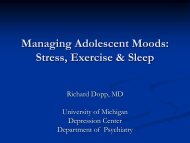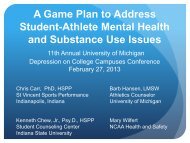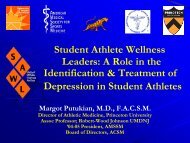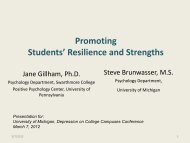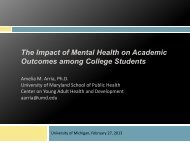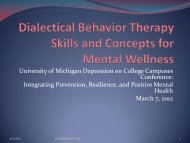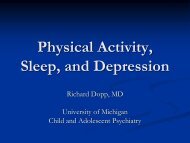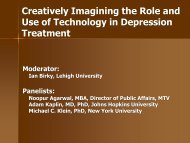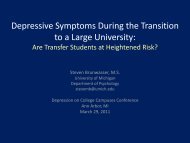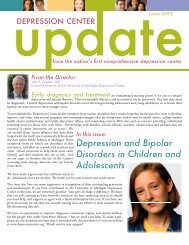Renee Rienecke Hoste, PhD - University of Michigan Depression ...
Renee Rienecke Hoste, PhD - University of Michigan Depression ...
Renee Rienecke Hoste, PhD - University of Michigan Depression ...
You also want an ePaper? Increase the reach of your titles
YUMPU automatically turns print PDFs into web optimized ePapers that Google loves.
Introduction to<br />
Eating Disorders<br />
<strong>Depression</strong> on College Campuses<br />
February 26, 2013<br />
Daniel E. Gih, M.D.<br />
Clinical Assistant Pr<strong>of</strong>essor, Section <strong>of</strong> Child & Adolescent Psychiatry<br />
Medical Director, U-M Comprehensive Eating Disorders Program<br />
1
Financial disclosures<br />
• None<br />
2
Eating Disorder Diagnoses<br />
• Anorexia nervosa (AN)<br />
• Bulimia nervosa (BN)<br />
• Eating disorder Not Otherwise Specified (EDNOS)<br />
• Not discussed in detail here<br />
• Feeding disorder <strong>of</strong> infancy or early childhood<br />
• Binge eating disorder<br />
• Obesity<br />
3
Disordered eating<br />
through the ages<br />
• Ancient Egypt - physicians recommended periodical purgation (enemas)<br />
as a health practice<br />
• Romans (~100 BC) – upper class (including Julius Caesar) vomited<br />
between meals so they could eat more (unrelated to vomitoria)<br />
• Renaissance (14 th -17 th century) – “Holy anorexics”<br />
• 1689 - first medical description by Richard Morton (physician to the<br />
court <strong>of</strong> England): fasting and emaciation without apparent medical<br />
causation (“nervous consumption”)<br />
• 1764 - Robert Whytt described bradycardia <strong>of</strong> anorexics<br />
• 1873 - two neurologists, Ernest Charles Lasegue and Sir William Gull,<br />
separately described “anorexia nervosa” (Gull’s term)<br />
• 1979 - Gerald Russell described bulimia nervosa<br />
4<br />
References: Eur Neurol. 2004;52(4):191-2<br />
Eur Neurol. 2006;55(1):53-6.
DSM IV-TR Criteria for<br />
Anorexia Nervosa (AN)<br />
A. Refusal to maintain body weight at or above a<br />
minimally normal weight <strong>of</strong> age and height (weight loss<br />
or failure to gain weight normally leading to < 85% <strong>of</strong><br />
expected weight)<br />
B. Intense fear <strong>of</strong> gaining weight/being fat, even though<br />
underweight<br />
C. Disturbed body image/shape, undue influence <strong>of</strong> body<br />
image on self-evaluation, or denial <strong>of</strong> seriousness <strong>of</strong><br />
current low body weight<br />
D. In postmenarchal females, amenorrhea for 3+<br />
cycles/months<br />
Specify type:<br />
• Restricting type<br />
• Binge-eating purge type 5
DSM IV-TR Criteria for<br />
Bulimia Nervosa (BN)<br />
A. Recurrent episodes <strong>of</strong> binge eating.<br />
1. Eating in a discrete period <strong>of</strong> time an amount larger than most<br />
people would eat under time/circumstances<br />
2. Sense <strong>of</strong> lack <strong>of</strong> control over eating during the episode<br />
B. Recurrent compensatory behavior: purging,<br />
laxatives, diuretics, enemas, fasting, exercise<br />
C. Binge eating, twice a week (average) for 3 months.<br />
D. Self-evaluation unduly influenced by body image<br />
or shape<br />
E. Disturbance does not occur exclusively during<br />
episodes <strong>of</strong> anorexia nervosa<br />
Specify type<br />
• Purging type (usually by self-induced vomiting or laxative abuse)<br />
• Nonpurging type (fasting, exercise)<br />
6
Eating Disorder NOS (EDNOS)<br />
1. For females, all <strong>of</strong> the criteria for Anorexia Nervosa are met except<br />
that the individual has regular menses.<br />
2. All <strong>of</strong> the criteria for Anorexia Nervosa are met except that, despite<br />
significant weight loss, the individual’s current weight is in the normal<br />
range.<br />
3. All <strong>of</strong> the criteria for Bulimia Nervosa are met except that the binge<br />
eating and inappropriate compensatory mechanisms occur at a<br />
frequency <strong>of</strong> less than twice a week or for a duration <strong>of</strong> less than 3<br />
months.<br />
4. The regular use <strong>of</strong> inappropriate compensatory behavior by an<br />
individual <strong>of</strong> normal body weight after eating small amounts <strong>of</strong> food<br />
(e.g., self-induced vomiting after the consumption <strong>of</strong> two cookies).<br />
5. Repeatedly chewing and spitting out, but not swallowing, large<br />
amounts <strong>of</strong> food.<br />
6. Binge-eating disorder (DSM IV-TR appendix)<br />
7
Summary <strong>of</strong> Binge Eating Disorder (BED)<br />
• Research (DSM IV-TR appendix)<br />
• Criteria<br />
A. Recurrent binge eating<br />
B. Binge eating associated with 3+<br />
1. Eating more rapidly than normal<br />
2. Eating until feeling uncomfortably full<br />
3. Eating large amounts <strong>of</strong> food when not feeling physically hungry<br />
4. Eating alone because <strong>of</strong> being embarrassed by how much one is eating<br />
5. Feeling disgusted, depressed, very guilty after overeating<br />
C. Marked distress regarding binge eating<br />
D. At least 2 days a week for 6 months<br />
E. No compensatory behavior follows, not in course <strong>of</strong><br />
anorexia/bulimia<br />
• Obesity is not required, but sometimes present<br />
8
DSM-5 (May 2013)<br />
9
DSM-V Feeding and Eating<br />
Disorders (as <strong>of</strong> July 2012)<br />
• Pica<br />
• Rumination Disorder<br />
• Anorexia Nervosa<br />
• Bulimia Nervosa<br />
• Binge Eating Disorder<br />
• Avoidant/Restrictive Food Intake Disorder<br />
(Feeding Disorder <strong>of</strong> Infancy or Early Childhood)<br />
• Feeding or Eating Disorder Not Elsewhere<br />
Classified (DSM-IV ED NOS) 10
Recent numbers<br />
• NCS-R 2007 report (community study)<br />
• AN lifetime prevalence: 0.9% women, 0.3% men<br />
• BN lifetime prevalence: 1.5% women, 0.5% men<br />
• Adolescent ED<br />
• EDNOS most common (57%) diagnosis (Eddy et al. 2008)<br />
• Prevalences: 0.3% (AN), 0.9% (BN), 1.6% (BED) [Swanson 2011]<br />
• Increases in U.S. hospitalizations for eating disorders,<br />
1999–2000 to 2005–2006 (AHRQ, 2009)<br />
• 18% increase in all ages<br />
• 119% increase in children under age 12<br />
11
Challenging our ED assumptions<br />
Then<br />
• Associated with affluent,<br />
Caucasian females<br />
• Illness confined to<br />
western and<br />
postindustrial societies<br />
• 9:1 female to male ratio<br />
(per DSM-IV)<br />
Now<br />
• Parental education,<br />
household income, and<br />
parental/ surrogate marital<br />
status not significantly<br />
associated with any<br />
adolescent ED (Swanson, et<br />
al., 2011)<br />
• Non-Hispanic white<br />
reported more AN;<br />
Hispanics, highest<br />
prevalence <strong>of</strong> BN<br />
• Global distribution seen<br />
• 3:1 F/M ratio (NCS-R 2007<br />
report) 12
Likely multifactorial etiology<br />
• Biological<br />
• Genetic predispositions<br />
• Pubertal hormones (trigger phenotypic expressions)<br />
• Serotonin dysfunction (low 5-HIAA levels in CSF)<br />
• Severe dieting<br />
• Childhood anxiety disorders (precede eating disorders)<br />
• Psychological<br />
• Personality features (anxious, avoidant for AN)<br />
• Conflicts with adolescent development?<br />
• Social<br />
• Competitive activities (e.g., gymnastics, running, wrestling,<br />
dance, modeling)<br />
• Sexual abuse<br />
13<br />
• Peer groups (i.e., sororities), exposure to media (Mazzeo, 2009)
Eating disorders begin in<br />
adolescence<br />
• Rare in younger children (< 5% occur<br />
prepubertal)<br />
• ~95% cases <strong>of</strong> AN occur before age 25 (Hoek and<br />
Hoeken, 2003)<br />
• National Comorbidity Survey Replication<br />
Adolescent Supplement (NCS-A) data (2011):<br />
median onset<br />
• AN 12.3 years<br />
• BN 12.4<br />
• BED 12.6 14
Early warning signs<br />
• Diet books<br />
• Dieting behaviors<br />
• Sudden decision to become a vegetarian<br />
• Increased picky eating, especially eating only “healthy<br />
foods”<br />
• Always going to the bathroom immediately after eating<br />
• Multiple showers in a day, especially following meals<br />
• Skipping meals or large amounts <strong>of</strong> food missing<br />
• Evidence <strong>of</strong> visiting pro-anorexia or eating disorder web<br />
sites
College health<br />
providers and staff are<br />
likely in positions to<br />
screen for eating<br />
disorders.<br />
What should we look out for? 16
The SCOFF questionnaire*<br />
• Do you make yourself Sick because you feel<br />
uncomfortably full?<br />
• Do you worry you have lost Control over how much you<br />
eat?<br />
• Have you recently lost more than One stone (14 lbs) in a<br />
3 month period?<br />
• Do you believe yourself to be Fat when others say you<br />
are too thin?<br />
• Would you say that Food dominates your life?<br />
*One point for every “yes”; a score <strong>of</strong> 2 indicates a likely case <strong>of</strong><br />
anorexia nervosa or bulimia (for adults)<br />
17
Differential diagnoses<br />
AN<br />
• Diabetes mellitus<br />
• Inflammatory bowel<br />
disease (IBD)<br />
• Thyroid disease<br />
• Addison's<br />
disease/adrenal<br />
insufficiency<br />
• Brain tumors<br />
BN<br />
• <strong>Depression</strong><br />
• Kleine-Levin<br />
syndrome<br />
• Gastric outlet<br />
obstruction<br />
• Hyperemesis<br />
gravidarum<br />
18
Illness course<br />
AN<br />
• Meta-analysis and 21 year<br />
follow up (Steinhausen,<br />
2002, Zipfel 2000)<br />
• ~50% recovered (return <strong>of</strong><br />
menses, weight gain)<br />
• 10-20% remained<br />
chronically ill<br />
• 15.6% AN-related death (in<br />
21 year follow up)<br />
• Little improvement in<br />
success rates over last 5<br />
decades<br />
BN<br />
• Steinhausen 2009<br />
analysis<br />
• 45% full recovery<br />
• ~23% chronic protracted<br />
course<br />
• 27% on average improved<br />
considerably<br />
• 0.32% crude mortality rate<br />
• Highest recovery rates<br />
between 4 and 9 years<br />
during follow-up 19
Eating disorders<br />
affect nearly every<br />
organ and may lead<br />
to death.<br />
20
Medical complications <strong>of</strong> AN<br />
• Cardiovascular<br />
• Decreased cardiac mass,<br />
congestive heart failure<br />
• EKG changes (low voltage,<br />
increased QTc)<br />
• Bradycardia, arrhythmia<br />
• Hypotension<br />
• Sudden cardiac death<br />
• Mitral valve prolapse<br />
• Gastrointestinal<br />
• Gastroparesis<br />
• Decreased motility<br />
• Acute vascular compression <strong>of</strong><br />
the duodenum<br />
• Endocrine<br />
• Low T3, high reverse T3<br />
• Increased corticotropin releasing<br />
hormone (potent anorectic)<br />
• Growth disturbance*<br />
• Osteoporosis*<br />
• Psychiatric<br />
• Suicide<br />
• Renal<br />
• Stones<br />
• Refeeding syndrome<br />
• Partial diabetes insipidus<br />
• Neurologic<br />
• Lowered olfactory and gustatory<br />
sensitivities<br />
• Brain changes/atrophy*<br />
(* May be permanent)<br />
21
Medical complications <strong>of</strong> BN<br />
• Cardiovascular<br />
• Dizziness<br />
• Hypotension<br />
• fluid and electrolyte<br />
imbalances<br />
• Cardiomyopathy (ipecac use)<br />
• Cardiac arrhythmias<br />
(potassium depletion)<br />
• Dental<br />
• Caries<br />
• Enamel loss<br />
• Periodontal disease<br />
• Gastrointestinal<br />
• Parotidomegaly<br />
• Sore throat<br />
• Esophagitis<br />
• Mallory-Weiss tears<br />
• Esophageal rupture<br />
(Boerhaave’s syndrome)<br />
• Diminished gastroesophageal<br />
sphincter tone (predisposes to<br />
pulmonary aspiration)<br />
• Reflex constipation (stimulant<br />
laxatives)<br />
• Cathartic colon (prolonged<br />
laxative use) 22<br />
Mehler PS. International Journal <strong>of</strong> Eating Disorders. 44(2):95-104, 2011 Mar.
Suicide<br />
• 32x higher than expected (Br J Psychiatry.<br />
1998 Jul;173:11-53)<br />
• Meta-analysis: 1 in 5 deaths in AN (Arch Gen<br />
Psychiatry. 2011;68(7):724-731)<br />
23
Eating disorders are complex<br />
• Psychiatric diagnoses<br />
with substantial medical<br />
morbidity and mortality<br />
• Multifactorial etiology<br />
including genetics and<br />
environment<br />
• Pr<strong>of</strong>ound psychological<br />
disturbance<br />
• A coordinated<br />
multidisciplinary team<br />
<strong>of</strong>fers best hope for<br />
recovery<br />
24<br />
http://www.abkontakt.se/?
Family-Based Treatment for Eating Disorders<br />
<strong>Renee</strong> <strong>Rienecke</strong> <strong>Hoste</strong>, <strong>PhD</strong><br />
Clinical Assistant Pr<strong>of</strong>essor <strong>of</strong> Psychiatry<br />
Director <strong>of</strong> Clinical Services and Research, UM-CEDP<br />
<strong>Depression</strong> on College Campuses<br />
February 26, 2013
History and Background<br />
“The patients should be fed at<br />
regular intervals, and<br />
surrounded by persons who<br />
would have moral control<br />
over them; relatives and<br />
friends being generally the<br />
worst attendants.”<br />
Sir William Gull<br />
(1816-1890)
Jean Martin Charcot<br />
(1825-1893)<br />
“It is necessary to<br />
separate both<br />
children and adults<br />
from their father and<br />
mother, whose<br />
influence, as<br />
experience teaches, is<br />
particularly<br />
pernicious.”
History <strong>of</strong> treatment for<br />
eating disorders<br />
Parental involvement deferred until eating disorder<br />
behavior under control<br />
Patients typically hospitalized<br />
Separation was desirable, because the family will<br />
interfere in the treatment <strong>of</strong> the eating disorder<br />
(“parentectomy”)<br />
Outpatient care emphasized adolescent’s need for<br />
separation, individuation and autonomy<br />
4
The Maudsley Hospital<br />
Hospital
The Maudsley Approach<br />
----------------------------------------------------------------------------------------------------------------<br />
There is little doubt that the presence<br />
<strong>of</strong> an ED has a major impact on family<br />
life. With time, food, eating, and their<br />
concomitant concerns begin to<br />
saturate the family fabric.<br />
Consequently, daily family routines as<br />
well as coping and problem solving<br />
behaviors are all affected.<br />
Ivan Eisler, Principal<br />
Architect <strong>of</strong> the<br />
Maudsley Approach
The Maudsley Approach<br />
Refined at <strong>University</strong> <strong>of</strong> Chicago and Stanford<br />
<strong>University</strong> by Daniel Le Grange and James Lock<br />
Theoretically agnostic<br />
Parents are a resource with no blame directed toward<br />
either the parents or the ill adolescent<br />
Siblings play a supportive role and are protected from<br />
the job assigned to the parents
Suitability and Context<br />
Appropriate for children and adolescents, >75% IBW and<br />
otherwise medically stable<br />
Outpatient intervention designed to a) restore weight<br />
and b) put adolescent development back on track<br />
Brief hospitalization to resolve medical concerns<br />
May not be suitable for families with severe parental<br />
psychopathology or serious discord in relationship<br />
between parents
Treatment Team<br />
FBT is a team approach<br />
Primary therapist: responsible for FBT and<br />
coordinating care<br />
Pediatrician/Adolescent Medicine Specialist:<br />
responsible for the medical safety <strong>of</strong> patient<br />
Child/Adolescent Psychiatrist: manages<br />
meds/comorbid disorders<br />
Consistency is key! Team members need to be on<br />
the same page and giving the same messages to<br />
each family member
What does treatment<br />
look like?<br />
Adolescent Anorexia Nervosa
Treatment Structure
Treatment Phases
Treatment Style<br />
• Therapist balances an active stance (mobilizing<br />
parental anxiety) with deference to the parents’<br />
judgment (empowerment)
Fundamental Assumptions<br />
------------------------------------------------------------------------------------------------------------------------<br />
• Agnostic view <strong>of</strong> cause <strong>of</strong> illness<br />
• Neither parents nor adolescent are to blame<br />
• Non authoritarian therapeutic stance<br />
• Joining with family<br />
• Parents are responsible<br />
• Empowerment<br />
• Externalization<br />
• Separation <strong>of</strong> child and illness<br />
• Initial focus on symptoms<br />
• Pragmatic
Initial Symptom Focus<br />
--------------------------------------------------------------------------------------------------------------------<br />
• Emphasis is first on behavioral change<br />
• History-taking focuses on symptom development<br />
• Delay <strong>of</strong> other issues until patient is less<br />
behaviorally and psychologically involved with<br />
ED<br />
• No direct cognitive focus with adolescent
Effects <strong>of</strong> FBT Tenets<br />
-----------------------------------------------------------------------------------------------------------------<br />
Highly focused, staged treatment<br />
Emphasis on behavioral recovery rather than<br />
insight and understanding or cognitive change<br />
This approach might indirectly improve family<br />
functioning and cognitive change
Overview <strong>of</strong> Phase 1<br />
------------------------------------------------------------------------------------------------------------------<br />
• Focus is on helping parents take control <strong>of</strong> weight<br />
restoration processes<br />
• Lasts between 8-10 sessions, usually weekly<br />
• Designed to help parents replicate at home what<br />
would happen on an inpatient unit<br />
• Principle aim is to help parents disrupt severe<br />
dieting, exercise, and related dysfunctional<br />
behaviors that are leading to or maintaining low<br />
weight
Session One<br />
----------------------------------------------------------------------------------------------------------<br />
Goals:<br />
<br />
<br />
<br />
<br />
Engage the family<br />
Obtain a history <strong>of</strong> how AN affects family<br />
Assess family functioning (coalitions, conflicts)<br />
Reduce parental blame<br />
Interventions include:<br />
<br />
<br />
<br />
<br />
Separating illness from patient<br />
Addressing parental anxiety<br />
Charging parents with the task <strong>of</strong> weight restoration<br />
Summary <strong>of</strong> session, instructions for family meal
Session Two: The Family Meal<br />
---------------------------------------------------------------------------------------------------------------<br />
Goals:<br />
Coach parents regarding ways to interact with<br />
the eating disorder and with their child<br />
Provide opportunity for parents to succeed in<br />
convincing patient to eat more than intended<br />
Assess family process during eating
Remainder <strong>of</strong> Phase I<br />
---------------------------------------------------------------------------------------------------<br />
Goals:<br />
Keep the family focused on the AN<br />
Help the parents take charge <strong>of</strong> child’s eating<br />
Mobilize sibling support for patient
Research Support for FBT<br />
Controlled studies <strong>of</strong> adolescent AN<br />
Russell et al (1987) / Eisler et al (1997)<br />
Le Grange et al (1992) / Eisler et al (2000) / Eisler et al (2007)<br />
Robin et al (1994) / Robin et al (1999)<br />
Lock et al (2005) / Lock et al (2006)<br />
Gowers et al (2007)<br />
Lock et al (2010)<br />
Godart et al (2012)
Lock et al., 2010<br />
12 months <strong>of</strong> family-based treatment (FBT) or adolescentfocused<br />
individual therapy (AFT)<br />
Similarly effective in producing full remission at end <strong>of</strong><br />
treatment<br />
FBT was significantly more effective in facilitating full<br />
remission at 6 and 12 month follow up points<br />
FBT should be the first line intervention for adolescents<br />
with AN who are medically fit for outpatient treatment<br />
Most patients respond favorably after relatively few<br />
treatment sessions if illness is recognized early on<br />
AFT could be a credible alternative for some patients
Manualized family-based treatment for AN<br />
Manual (Lock, et al., 2001)<br />
implemented in research<br />
studies<br />
<br />
<br />
<br />
<br />
23<br />
Allows for testing in<br />
controlled and uncontrolled<br />
settings<br />
Reference tool for therapists<br />
Studies support parents are a<br />
resource and it is feasible and<br />
useful to incorporate them<br />
into the treatment <strong>of</strong> an<br />
adolescent<br />
Parent handbook now available<br />
(2005)
Treatment for Adults with AN<br />
There is no clear first-line treatment for adults with AN<br />
The NIMH outlines three important components in<br />
treatment <strong>of</strong> adults:<br />
Weight restoration<br />
Reducing or eliminating the behaviors or thoughts related to<br />
the eating disorder, along with relapse prevention<br />
Treating the psychological issues related to the eating disorder
FBT for Young Adults<br />
• Families continue to play a significant role in the<br />
lives <strong>of</strong> their young adult children<br />
• How does FBT-Y differ from FBT-AN?<br />
• Approach is more collaborative<br />
• Family <strong>of</strong> choice<br />
• Developmental issues<br />
• Time with patient
FBT-Y Case Series (Chen et al., 2010)<br />
Four young adults (ages 18-21)<br />
Duration <strong>of</strong> illness: 12-42 months<br />
Treatment sessions: 11-20 over 6-12 months<br />
Assessments conducted at baseline, end <strong>of</strong> treatment, and<br />
6-month follow-up
BMI<br />
FBT-Y Case Series<br />
20.5<br />
20<br />
19.5<br />
19<br />
18.5<br />
18<br />
17.5<br />
17<br />
16.5<br />
16<br />
15.5<br />
BL EOT 6mo<br />
(Chen et al., 2010)
EDE Global Score<br />
FBT-Y Case Series<br />
1.6<br />
1.4<br />
1.2<br />
1<br />
0.8<br />
0.6<br />
0.4<br />
0.2<br />
0<br />
BL EOT 6mo<br />
(Chen et al., 2010)
BDI<br />
FBT-Y Case Series<br />
18<br />
16<br />
14<br />
12<br />
10<br />
8<br />
6<br />
4<br />
2<br />
0<br />
BL EOT 6mo<br />
(Chen et al., 2010)
FBT for Young Adults<br />
FBT-Y is still in development<br />
FBT-Y may be promising<br />
No first-line treatment for this population<br />
Similarities between older adolescents and young adults<br />
Research is needed to create and identify effective<br />
treatments for adults with AN
31<br />
U-M Comprehensive Eating Disorders Program<br />
www.u<strong>of</strong>mhealth.org/eatingdisorders<br />
734-232-7531
U-M Comprehensive Eating<br />
Disorders Program<br />
Ages 8-24 with primary AN or restrictive eating/weight loss<br />
Currently two tracks available (8-17; 18-24)<br />
Partial Hospitalization Program (6 hours/day, Monday-Friday):<br />
Group and individual/family therapy along with two meals<br />
and snack<br />
Primary treatment philosophy is FBT<br />
Adult caregiver required for children and adolescents<br />
“Support person” strongly recommended for young adult patients<br />
32
U-M CEDP<br />
Multidisciplinary outpatient intake evaluation<br />
Eligible patients will be entered into the PHP<br />
Step down care to intensive outpatient program (IOP)<br />
Coordinate care with outpatient mental health providers<br />
in the community
FBT in a PHP<br />
Parent participation is required daily<br />
Parents choose meals, can bring food from home<br />
Parent debriefing<br />
All families go through Sessions 1 and 2 before joining<br />
PHP<br />
Parent skills group<br />
Group therapies target associated psychopathology and<br />
risk factors
Group Therapies<br />
Dialectical Behavior Therapy<br />
Cognitive Behavior Therapy (perfectionism and selfesteem)<br />
Cognitive Remediation Therapy<br />
Body Image<br />
Psychoeducation<br />
Process group<br />
Relaxation<br />
Self-expression
Next steps<br />
Educational and provider outreach<br />
Working with psychiatric inpatient unit<br />
Developing evidence-based tracks for BN<br />
Outpatient clinic<br />
Developing research program<br />
36
Research Program<br />
At intake, patients complete two semi-structured diagnostic<br />
interviews (MINI and EDE) by trained assessors<br />
Before starting PHP, patients and parents complete a number<br />
<strong>of</strong> self-report measures<br />
Child <strong>Depression</strong> Inventory<br />
Eating Disorder Examination Questionnaire<br />
Clinical Impairment Assessment<br />
Eating Disorder Inventory – 3<br />
Family Environment Scale<br />
Rosenberg Self-Esteem Scale<br />
Symptom Checklist-90-R<br />
Parent Vs. Anorexia Scale<br />
Family Questionnaire<br />
Working Alliance Inventory<br />
Yale-Brown Obsessive Compulsive Scale
Research Program<br />
Measures are completed at baseline, midtreatment, end <strong>of</strong><br />
treatment, and 3 month follow-up<br />
Will assess:<br />
<br />
<br />
<br />
<br />
Efficacy <strong>of</strong> treatment provided*<br />
Possible mechanisms <strong>of</strong> change, including family and marital<br />
relationships<br />
Predictors <strong>of</strong> outcome<br />
Adapting FBT for a PHP setting<br />
Long-term goals:<br />
<br />
<br />
<br />
<br />
Research funding to compare FBT-PHP to traditional outpatient FBT<br />
Collaboration with other research teams to develop treatments to<br />
assist parents in refeeding at home<br />
Adapt treatment as needed<br />
Develop additional parent interventions
Eating Disorder Websites<br />
Local<br />
<br />
<br />
www.edleague.com<br />
www.u<strong>of</strong>mhealth.org/eatingdisorders<br />
National<br />
<br />
<br />
<br />
<br />
<br />
<br />
<br />
www.maudsleyparents.org<br />
www.aedweb.org<br />
www.nationaleatingdisorders.org<br />
www.train2treat4ed.com<br />
www.edreferral.com<br />
www.feast-ed.org<br />
www.anad.org<br />
Books and resources<br />
<br />
www.bulimia.com<br />
39



